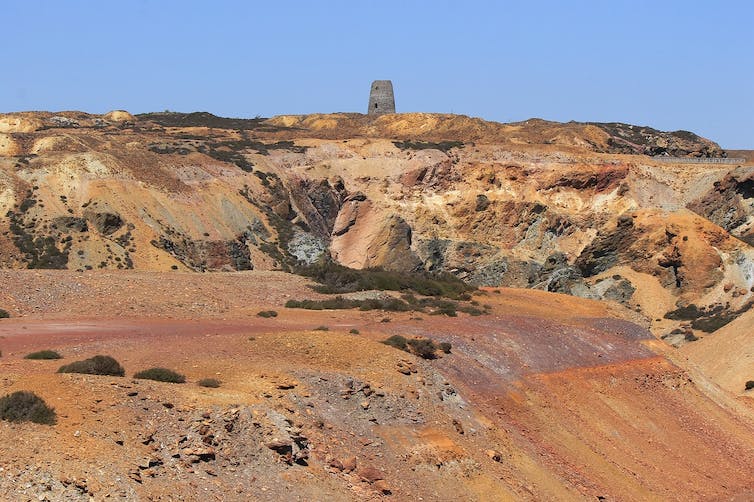A halfpenny token issued by the Parys Mining Company of Anglesey in 1788. The hooded druid design was used for a few years and was the primary of tons of of token designs. BrandonBigheart/Wikimedia
You may also learn this text in Welsh.
The international cryptocurrency market has seen various current setbacks: from the collapse of the Terra/Luna system in May 2022 to the failure of FTX, one of many largest crypto exchanges on this planet.
Because of those elements, and different considerations over cryptocurrencies’ carbon emissions, these belongings misplaced US$2 trillion in worth (£1.5 trillion) in 2022.
But whereas cryptocurrencies get a variety of consideration in the present day, in some methods they don’t seem to be a revolutionary idea. Hundreds of years in the past, staff in Wales had been typically paid with different currencies as an alternative of cash.
These currencies had been bodily tokens that represented and had been linked to the worth of actual cash. Many cryptocurrencies work in an identical manner, performing as digital tokens that characterize a ledger of economic belongings (this is called “tokenisation”).
Digital currencies are additionally not reliant on any central authority, equivalent to a authorities or financial institution, to uphold or preserve their community of trade. Again, that is much like how bodily tokens had been utilized by Welsh mining firms.
Currency disaster
Towards the top of the 18th century the coinage of Britain was in a deplorable state as a result of extreme shortages of silver and copper cash. During the Industrial Revolution folks migrated from the countryside into mining and manufacturing centres. But residing in cities required cash, and the flexibility to pay wages was not possible for companies with out small change.
With an inflow of latest staff utilizing cash, new outlets had been opened to fulfill demand, creating extra jobs that required cost in cash. Although the manufacturing of counterfeit cash was unlawful and punishable by dying, it was not unlawful to provide tokens with different designs which might be used as an alternative of cash.
The first nice period of token manufacturing throughout the first Industrial Revolution started in 1787 with the problem of the Parys Mining Company token. This firm mined at Parys Mountain on the Welsh island of Anglesey. It briefly produced extra copper than some other mine on this planet throughout the Industrial Revolution.

What Parys mountain on Anglesey appears like in the present day.
rhianjane/Pixabay
It additionally used the high-quality ore from its mine to provide tokens which might be exchanged for official coin at full worth at any certainly one of its outlets or workplaces. This made the Parys Mining Company the primary firm on this planet to problem tokens. These had been described because the “premier tokens” of the 18th century by that period’s coin specialists.
Soon, virtually each city in Britain was producing its personal tokens. This was pushed partially by a scarcity of presidency coinage and enhancements in coin manufacturing by Matthew Boulton’s Soho Mint in Birmingham, who additionally turned his hand to tokens.
By the flip of the nineteenth century, the full provide and quick circulation of tokens, overseas cash and different substitutes most likely exceeded these of the official coin of the nation.
The means of tokenisation was subsequently seen in different nations, particularly the United States. Mining and logging camps within the nineteenth century US had been sometimes owned and operated by a single firm, typically in distant areas with poor entry to money.
These firms would typically pay their staff in “scrip”, or tokens. The staff, given the restricted locations they may spend scrips, had little alternative however to buy items at company-owned shops. By putting massive mark ups on items, the corporate may enhance their earnings and implement worker loyalty.

A Parys penny produced by the Parys Mining Company.
Obscurasky/Wikimedia
While the manufacturing of tokens by the Parys Mining Company had been spurred on by the primary Industrial Revolution, the adoption and recognition of Bitcoin and different cryptocurrencies has been hastened by the fourth Industrial Revolution.
Although they’re greater than 200 years aside, the historical past of those tokens have necessary classes for in the present day’s cryptocurrencies. First, for cryptocurrencies to succeed there must be numerous methods for people to build up the crypto/tokens, plus a requirement and use for the crypto meaning it holds its worth, and trusted environments the place trade for items and companies can happen.
And second, for cryptocurrencies to achieve success and sustainable in the long run they need to uphold their unique objective of getting an ecosystem that is still impartial of a single firm or authorities. Efforts to lock cryptocurrencies to a single organisation don’t look constructive, for instance Facebook’s failed try to launch a cryptocurrency, introduced in 2019.
The tokens of Welsh mining firms inherently failed when the closures of the mine or outlets led to the elimination of a number of of the three parts of the ecosystem. And then folks left with the tokens misplaced their cash, a lesson for us in the present day.
![]()
The authors don’t work for, seek the advice of, personal shares in or obtain funding from any firm or organisation that might profit from this text, and have disclosed no related affiliations past their tutorial appointment.
